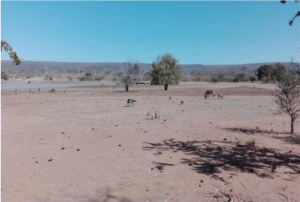Erratic rainfall and poor water management practices have a direct negative impact on the water availability in the rural communities of Binga and Buhera districts, located in the Lower Gwayi and Upper Save catchments of Zimbabwe. As a result, water sources often dry up during the September to November dry season, causing the failure of crops and animal productive systems during this period. The largest burden of this water insecurity is put on women and particularly girls, as they are forced to miss out on other crucial opportunities, such as education, when having to walk for more than 10km to fetch water. Even during the rainfall season, the precipitation that is received is very limited (<400 mm) and unreliable, therefore strategies are required to improve and protect livelihoods in periods with little or no rainfall.
Due to limited adaptation options, an increase in unsustainable activities along key value chains is observed, leading to land degradation and deterioration of key water sources. Poor land husbandry practices have degraded crucial water resources systems such as wetlands and natural sand dams, which are incrementally reducing their ability to provide ecosystem services. The other challenge, as in most poor areas in Zimbabwe, is related to poor value chains. Some business ventures such as beekeeping and goat rearing have not been successful because of the limited scale of the projects and disorganized markets. These challenges are happening in a space where there is a weak institutional framework for farmers to participate viably in priority value chains, with weak adaptive capacities among the smallholder communities and low application of climate smart technologies.
To address several of these challenges, this Project aims to increase local communities’ adaptive capacity and resilience to climate change through sustainable groundwater utilisation for food security and other productive uses in rural areas of Zimbabwe. To achieve this, an array of actions are required starting at national to local levels and involving institutional reforms and modelling, characterisation and quantification of the groundwater resources, knowledge generation and capacity development, and awareness raising through piloting and demonstration.
| Project Component 1: To strengthen technical, institutional and human capacity for improved and sustainable utilization of groundwater at national and local levels | US$ 419,689 |
| Project Component 2: To conduct comprehensive assessments of groundwater resources in two poverty-stricken and highly vulnerable sub-catchments of Lower Gwayi and Upper Save and develop sample plans for improving climate resilience through sustainable groundwater utilization | US$ 300,000 |
| Project Component 3: To strengthen the capacity of water and land management institutions in Lower Gwayi and Upper Save sub-catchments by developing integrated catchment management plans that promote groundwater use whilst protecting groundwater resources | US$ 145,750 |
| Project Component 4: To pilot and demonstrate concrete climate change adaptation measures based on sustainable groundwater utilisation by diversifying and strengthening the livelihoods of the most vulnerable population in Lower Gwayi and Upper Save sub-catchments | US$ 3,226,402 |
| Project Component 5: To compile and disseminate lessons learnt from the project to facilitate future upscaling and replication of good practices in groundwater extraction and management | US$ 100,000 |
| Project execution cost (including M&E) | US$ 437,789 |
| Total project cost (execution included) | US$ 4,629,630 |
| UNESCO management fee | US$ 370,370 |
| Grant Amount | US$ 5,000,000 |
Project Documents
| Attachment | Type | Size |
|---|---|---|
| Inception Report | 3 MB |



